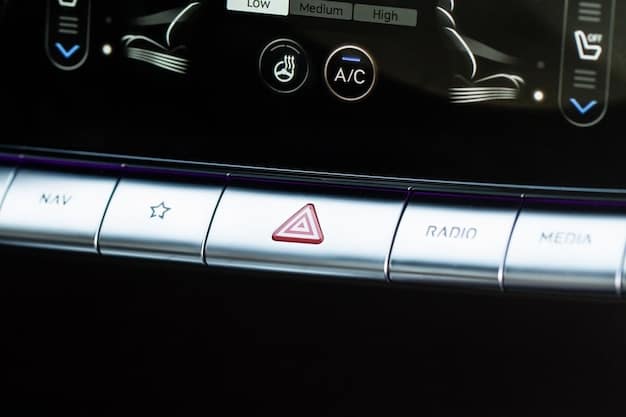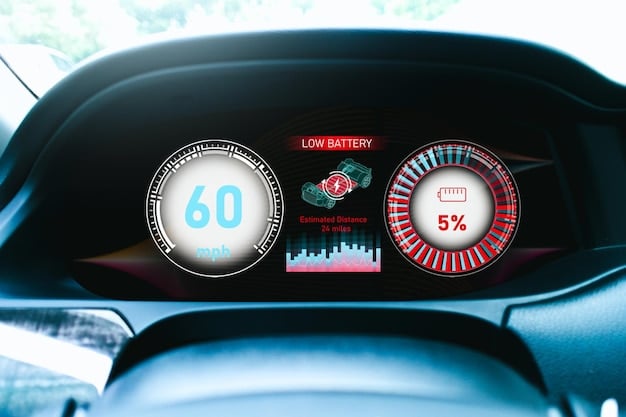Emerging Trends in Automotive Cybersecurity for US Car Owners

Emerging trends in automotive cybersecurity for US car owners include advanced threat detection systems, AI-driven security solutions, secure over-the-air (OTA) updates, blockchain technology for data protection, and standardization of security protocols, all aimed at mitigating increasing cyber threats to connected vehicles.
The automotive industry is undergoing a massive transformation, with cars becoming increasingly connected, autonomous, and electric. While these advancements offer numerous benefits, they also introduce new cybersecurity vulnerabilities. Understanding what are the emerging trends in automotive cybersecurity and their implications for US car owners is crucial for ensuring safety and security on the road.
Understanding the Evolving Threat Landscape
The threat landscape for automotive cybersecurity is becoming increasingly sophisticated and complex. As vehicles become more connected, they offer more points of entry for cyberattacks. These attacks can range from simple data theft to more dangerous scenarios like remote control of vehicle functions.
Understanding these threats is the first step in protecting yourself and your vehicle. It’s no longer enough to simply rely on traditional security measures. A proactive and informed approach is necessary.
Types of Cyber Threats
Several types of cyber threats target modern vehicles. These include:
- Malware Infections: Viruses and other malicious software can compromise vehicle systems, leading to data theft or functional impairment.
- Remote Hacking: Attackers can remotely access and control vehicle functions, posing a significant safety risk.
- Data Breaches: Sensitive data, such as personal information and driving habits, can be stolen from vehicle systems and cloud servers.
The Impact on US Car Owners
The implications of these threats for US car owners are significant. A successful cyberattack can result in:
- Financial Losses: Repairing damaged systems and recovering stolen data can be costly.
- Safety Risks: Remote control of vehicle functions can lead to accidents and injuries.
- Privacy Violations: Stolen personal information can be used for identity theft and other malicious purposes.
The evolving threat landscape demands that car owners, manufacturers, and cybersecurity experts work together to develop and implement effective security measures. Staying informed and proactive is essential for mitigating these risks.

Key Cybersecurity Trends to Watch
Several key cybersecurity trends are emerging in the automotive industry. These trends are driven by the need to protect vehicles from increasingly sophisticated cyber threats. Staying aware of these trends can help US car owners make informed decisions about their vehicle security.
Manufacturers are constantly innovating to stay ahead of potential attackers. These emerging trends represent the cutting edge of automotive cybersecurity.
Advanced Threat Detection Systems
Advanced threat detection systems are designed to identify and respond to cyber threats in real-time. These systems use a variety of techniques to detect malicious activity, including:
- Anomaly Detection: Identifying unusual patterns of behavior that may indicate a cyberattack.
- Intrusion Detection: Monitoring network traffic for signs of unauthorized access.
- Behavioral Analysis: Analyzing the behavior of vehicle systems to detect malicious activity.
AI-Driven Security Solutions
Artificial intelligence (AI) is playing an increasingly important role in automotive cybersecurity. AI-driven security solutions can:
- Automate Threat Detection: AI algorithms can quickly and accurately identify cyber threats, reducing the need for human intervention.
- Improve Threat Response: AI can help automate the response to cyberattacks, minimizing the damage and downtime.
- Enhance Vulnerability Assessment: AI can be used to identify and assess vulnerabilities in vehicle systems.
These trends represent a significant step forward in automotive cybersecurity, offering enhanced protection against evolving cyber threats.
Secure Over-the-Air (OTA) Updates
Over-the-air (OTA) updates are becoming increasingly common in modern vehicles. These updates allow manufacturers to remotely update vehicle software, fix bugs, and add new features. However, OTA updates also introduce new cybersecurity risks.
Ensuring the security of OTA updates is crucial for protecting vehicles from cyberattacks. A compromised OTA update can be used to install malware or remotely control vehicle functions.
The Importance of Secure OTA Updates
Secure OTA updates are essential for maintaining the security of modern vehicles. These updates should be:
- Encrypted: Encrypted to prevent unauthorized access and modification.
- Authenticated: Authenticated to ensure that they come from a trusted source.
- Verified: Verified to ensure that they have not been tampered with.
Best Practices for OTA Security
Several best practices can help ensure the security of OTA updates, including:
- Using Secure Communication Channels: Using secure communication channels to transmit update data.
- Implementing Multi-Factor Authentication: Implementing multi-factor authentication to prevent unauthorized access to update systems.
- Performing Regular Security Audits: Performing regular security audits to identify and address vulnerabilities.
By following these best practices, manufacturers can help ensure that OTA updates are secure and reliable.

Blockchain Technology for Data Protection
Blockchain technology is emerging as a promising solution for protecting automotive data. Blockchain is a distributed ledger technology that can be used to securely store and manage data.
In the automotive industry, blockchain can be used to protect a variety of data, including:
- Vehicle Data: Data generated by vehicle sensors and systems.
- User Data: Personal information and driving habits.
- Supply Chain Data: Data related to the manufacturing and distribution of vehicle components.
Benefits of Blockchain
Blockchain offers several benefits for automotive cybersecurity, including:
- Improved Data Security: Blockchain’s distributed and immutable nature makes it difficult for attackers to tamper with data.
- Enhanced Data Transparency: Blockchain provides a transparent and auditable record of all data transactions.
- Increased Trust: Blockchain can help build trust between manufacturers, suppliers, and car owners.
Blockchain has the potential to revolutionize automotive cybersecurity, offering a more secure and transparent way to manage data.
Standardization of Security Protocols
The lack of standardized security protocols has been a major challenge for automotive cybersecurity. Different manufacturers use different security systems, making it difficult to ensure interoperability and consistent protection.
Standardization of security protocols is essential for creating a more secure and resilient automotive ecosystem. Standardized protocols can help:
- Improve Interoperability: Allow different vehicle systems and components to communicate securely.
- Enhance Threat Detection: Facilitate the sharing of threat intelligence and best practices.
- Reduce Costs: Lower the cost of developing and implementing security solutions.
Efforts Towards Standardization
Several organizations are working to develop and promote standardized security protocols for the automotive industry, including:
- SAE International: SAE International has developed several cybersecurity standards for the automotive industry, including SAE J3061.
- ISO: ISO is working on developing international standards for automotive cybersecurity.
- NIST: NIST is developing cybersecurity frameworks and guidelines for the automotive industry.
These efforts are helping to create a more secure and standardized automotive ecosystem.
The Role of US Car Owners in Cybersecurity
While manufacturers and cybersecurity experts play a crucial role in protecting vehicles from cyberattacks, US car owners also have a responsibility to protect themselves. There are several steps that car owners can take to improve their vehicle’s cybersecurity.
Being proactive and informed is key to mitigating the risks of cyberattacks. Simple steps can make a big difference in protecting your vehicle and personal information.
Best Practices for Car Owners
Here are some best practices that US car owners can follow to improve their vehicle’s cybersecurity:
- Keep Software Updated: Install software updates as soon as they become available.
- Use Strong Passwords: Use strong, unique passwords for all vehicle-related accounts.
- Be Cautious of Phishing Scams: Be cautious of phishing scams and avoid clicking on suspicious links.
Future Trends: What to Expect
Looking ahead, several future trends are expected to shape the automotive cybersecurity landscape, including:
- Increased Government Regulation: Governments are likely to increase regulation of automotive cybersecurity.
- Greater Collaboration: Greater collaboration between manufacturers, cybersecurity experts, and government agencies.
- Advanced Security Technologies: Development and deployment of advanced security technologies, such as quantum-resistant encryption.
| Key Aspect | Brief Description |
|---|---|
| 🛡️ Threat Detection | Advanced systems identify and respond to cyber threats in real time. |
| 🤖 AI Solutions | AI automates threat detection and enhances vulnerability assessment. |
| 📡 Secure OTA Updates | OTA updates are encrypted, authenticated, and verified to prevent compromise. |
Frequently Asked Questions
▼
The biggest risks include remote access to car systems, data theft, and malware infections. These can lead to compromised safety and privacy.
▼
You can protect your car by keeping software updated, using strong passwords, being cautious of phishing scams, and staying informed about security practices.
▼
Blockchain is a secure, distributed ledger that can protect car data by making it difficult for attackers to tamper with. It enhances data transparency.
▼
Standardized protocols improve interoperability, enhance threat detection, and reduce costs, leading to a more secure automotive ecosystem.
▼
Car manufacturers are responsible for implementing security measures, providing secure OTA updates, and collaborating with cybersecurity experts.
Conclusion
Staying informed about the emerging trends in automotive cybersecurity is paramount for US car owners. By understanding the risks and taking proactive steps, you can help protect your vehicle and personal information from cyber threats. As technology advances, so too must our approach to security, ensuring a safer and more secure driving experience for all.





